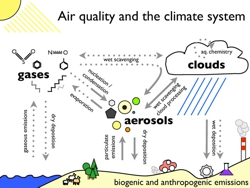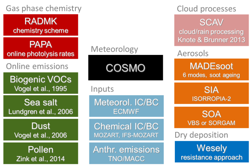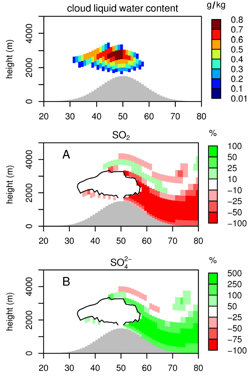Regional air quality modelling with COSMO-ART
Our air quality modelling activities focus on the accurate representation of short-lived, reactive trace gases and aerosols at the regional scale. We are investigating feedbacks within the coupled atmospheric system of gases, liquids and solid particles, and try to understand and quantify the effects of future changes in emissions on air pollution levels and the associated climate and health effects.
For this purpose we use and further develop the comprehensive, online-coupled modelling system COSMO-ART for a better understanding of the processes involved in air pollution, and establish near-real-time modelling capabilities to assess current events. We gain knowledge about the skills of our system through comprehensive model evaluation. We develop pre-processing tools to make the use of initial and boundary data from coarse grid simulations as well as emission inventories in the model possible. We provide a comprehensive anthropogenic emission dataset for Europe in a ready-to-use format for other users of COSMO-ART in collaboration with external partners. All our development efforts are available to and used by other members of our modelling community.
Possible applications of COSMO-ART
- understanding the reasons and mechanisms of past events with high air pollution levels (local sources vs. long-range transport, Saharan dust events, biogenic vs. anthropogenic sources)
- determining efficient strategies to reduce air pollution levels, especially particulate matter, using emissions scenarios
- studying climate effects of aerosols and their interactions, thereby reducing uncertainty in climate projections
COSMO-ART model system and developments
Supported by the Centre for Climate Systems Modelling (C2SM) the COSMO-ART modelling system has been implemented at Empa and is actively developed. This "online"-coupled regional chemistry climate model allows for consistent treatment of gas-phase chemistry, aerosol dynamics and meteorology, and for two-way feedback between each phase.
COSMO-ART, developed at KIT-Karlsruhe (Germany), provides a comprehensive description of the coupled gas-aerosol-meteorology system within the atmosphere. It is based on the operationally used numerical weather prediction system COSMO, which is used by several European meteorological services (DWD, MeteoSwiss, etc.). State-of-the-art additions for gas-phase chemistry (RADMKA), aerosols (MADEsoot extended) and their interactions (VBS or SORGAM for secondary organic aerosols and ISORROPIA 2 for secondary inorganic aerosols) are coupled in an "online"-manner to COSMO. It allows considering direct and indirect feedbacks of aerosols on radiation.
Implementation
The complex description of the multi-phase system makes the use of high-performance parallel computing facilities necessary. A typical simulation involves the use of 50 – 500 cores and runs for several days. We are using COSMO-ART on the massively parallel CRAY computing facilities of the Swiss National Supercomputing Center as well as on the Empa Cluster system HYPAZIA.
Aerosol-gases-cloud interactions
Aerosol-gases-cloud interactions
Coupling of gases and aerosols with clouds and precipitation is historically known as "wet scavenging", which refers to the process of reducing air pollutant concentrations through washout by falling precipitation. However, clouds and rain drops may not only remove air pollutants from the atmosphere but they also trigger additional chemical processes such as the oxidation of SO2 to sulphates and have important effects on the composition and size distributions of aerosols.
To account for these complex processes, we have coupled a sophisticated cloud chemistry and processing scheme, the SCAV submodel of the MESSy global modelling system. Therein, wet scavenging of gases and aerosols by both cloud droplets and precipitation is represented, including aqueous-phase chemistry. We have further developed this scheme for regional scale models where precipitation can be a 3D prognostic quantity, allowing for horizontal transport of rain and evaporation. This made the transport of the chemical composition of cloud droplets and rain drops necessary, additionally to smaller adaptations of the parameterisations in SCAV. The final coupled system allows for very detailed study of aerosol-gas-cloud interactions.
References:
- Palacios-Peña, L., Baró, R., Guerrero-Rascado, J. L., Alados-Arboledas, L., Brunner, D., & Jiménez-Guerrero, P. (2017). Evaluating the representation of aerosol optical properties using an online coupled model over the Iberian Peninsula. Atmospheric Chemistry and Physics, 17(1), 277-296. http://doi.org/10.5194/acp-17-277-2017.
- Kioutsioukis, I., Im, U., Solazzo, E., Bianconi, R., Badia, A., Balzarini, A., … Galmarini, S. (2016). Insights into the deterministic skill of air quality ensembles from the analysis of AQMEII data. Atmospheric Chemistry and Physics, 16(24), 15629-15652. http://doi.org/10.5194/acp-16-15629-2016
- Brunner, D., Savage, N., Jorba, O., Eder, B., Giordano, L., Badia, A., Balzarini, A., Baró, R., Bianconi, R., Chemel, C., Curci, G., Forkel, R., Jiménez-Guerrero, P., Hirtl, M., Hodzic, A., Honzak, L., Im, U., Knote, C., Makar, P., Manders-Groot, A., van Meijgaard, E., Neal, L., Pérez, J.L., Pirovano, G., San Jose, R., Schröder, W., Sokhi, R.S., Syrakov, D., Torian, A., Tuccella, P., Werhahn, J., Wolke, R., Yahya, K., Zabkar, R., Zhang, Y., Hogrefe, C., Galmarini, S., Comparative analysis of meteorological performance of coupled chemistry-meteorology models in the context of AQMEII phase 2, Atmos. Environ., doi: 10.1016/j.atmosenv.2014.12.032, 2015.
- Galmarini, S., C. Hogrefe, D. Brunner, P. Makar, and A. Baklanov (2015), Preface, Atmos. Environ., 115, 340-344.
- Knote, C., Tuccella, P., Curci, G., Emmons, L., Orlando, J.J., Madronich, S., Baró, R., Jiménez-Guerrero, P., Luecken, D., Hogrefe, C., Forkel, R., Werhahn, J., Hirtl, M., Pérez, J.L., San José, R., Giordano, L., Brunner, D., Yahya, K., Zhang, Y., Influence of the choice of gas-phase mechanism on predictions of key gaseous pollutants during the AQMEII phase-2 intercomparison, Atmos. Environ., doi:10.1016/j.atmosenv.2014.11.066, 2015.
- Giordano, L., Brunner, D., Flemming, J., Hogrefe, C., Im, U., Bianconi, R., Badia, A., Balzarini, A., Baro, R., Chemel, C., Curci, G., Forkel, R., Jimenez-Guerrero, P., Hirtl, M., Hodzic, A., Honzak, L., Jorba, O., Knote, C., Kuenen, J.J.P., Makar, P.A., Manders-Groot, A., Neal, L., Perez, J.L., Pirovano, G., Pouliot, G., San Jose, R., Savage, N., Schroder, W., Sokhi, R.S., Syrakov, D., Torian, A., Tuccella, P., Werhahn, J., Wolke, R., Yahya, K., Žabkar, R., Zhang, Y., Galmarini, S., Assessment of the MACC reanalysis and its influence as chemical boundary conditions for regional air quality modeling in AQMEII-2, Atmos. Environ., doi: 10.1016/j.atmosenv.2015.02.034, 2015.
- Curci, G., Hogrefe, C., Bianconi, R., Im, U., Balzarini, A., Baró, R., Brunner, D., Forkel, R., Giordano, L., Hirtl, M., Honzak, L., Jiménez-Guerrero, P., Knote, C., Langer, M., Makar, P.A., Pirovano, G., Pérez, J.L., San José, R., Syrakov, D., Tuccella, P., Werhahn, J., Wolke, R., Žabkar, R., Zhang, J., Galmarini, S., Uncertainties of simulated aerosol optical properties induced by assumptions on aerosol physical and chemical properties: An AQMEII-2 perspective. Atmos. Environ., doi: 10.1016/j.atmosenv.2014.09.009, 2015.
- Im, U., Bianconi, R., Solazzo, E., Kioutsioukis, I., Badia, A., Balzarini, A., Baró, R., Bellasio, R., Brunner, D., Chemel, C., Curci, G., Denier van der Gon, H., Flemming, J., Forkel, R., Giordano, L., Jiménez-Guerrero, P., Hirtl, M., Hodzic, A., Honzak, L., Jorba, O., Knote, C., Makar, P.A., Manders-Groot, A., Neal, L., Pérez, J.L., Pirovano, G., Pouliot, G., San Jose, R., Savage, N., Schroder, W., Sokhi, R.S., Syrakov, D., Torian, A., Tuccella, P., Wang, K., Werhahn, J., Wolke, R., Zabkar, R., Zhang, Y., Zhang, J., Hogrefe, C., Galmarini, S., Evaluation of operational online-coupled regional air quality models over Europe and North America in the context of AQMEII phase 2. Part II: Particulate matter. Atmos. Environ., doi:10.1016/j.atmosenv.2014.08.072, 2015.
- Im, U., Bianconi, R., Solazzo, E., Kioutsioukis, I., Badia, A., Balzarini, A., Baró, R., Bellasio, R., Brunner, D., Chemel, C., Curci, G., Flemming, J., Forkel, R., Giordano, L., Jiménez-Guerrero, P., Hirtl, M., Hodzic, A., Honzak, L., Jorba, O., Knote, C., Kuenen, J.J.P., Makar, P.A., Manders-Groot, A., Neal, L., Pérez, J.L., Pirovano, G., Pouliot, G., San Jose, R., Savage, N., Schroder, W., Sokhi, R.S., Syrakov, D., Torian, A., Tuccella, P., Werhahn, J., Wolke, R., Yahya, K., Zabkar, R., Zhang, Y., Zhang, J., Hogrefe, C., Galmarini, S., Evaluation of operational on-line-coupled regional air quality models over Europe and North America in the context of AQMEII phase 2. Part I: Ozone. Atmos. Environ., doi:10.1016/j.atmosenv.2014.09.042, 2015.
- Kong, X., Forkel, R., Sokhi, R.S., Suppan, P., Baklanov, A., Gauss, M., Brunner, D., Barò, R., Balzarini, A., Chemel, C., Curci, G., Jiménez-Guerrero, P., Hirtl, M., Honzak, L., Im, U., Pérez, J.L., Pirovano, G., San Jose, R., Schlünzen, K.H., Tsegas, G., Tuccella, P., Werhahn, J., Žabkar, R., Galmarini, S., Analysis of meteorology–chemistry interactions during air pollution episodes using online coupled models within AQMEII phase-2. Atmos. Environ., doi:10.1016/j.atmosenv.2014.09.020, 2015.
- Knote, C. and Brunner, D., An advanced scheme for wet scavenging and liquid-phase chemistry in a regional online-coupled chemistry transport model, Atmos. Chem. Phys., 13, 1177-1192, doi:10.5194/acp-13-1177-2013, 2013.
- Athanasopoulou, E., Vogel, H., Vogel, B., Tsimpidi, A.P., Pandis, S.N., Knote, C., Fountoukis, C.: Modeling the meteorological and chemical effects of secondary organic aerosols during an EUCAARI campaign. Atmos. Chem. Phys., 13, 625-645, 2013.
- Knote, C., 2012. Regional scale impacts of changing anthropogenic emissions on aerosols. Dissertation, ETHZ; Empa Dübendorf, Switzerland, 165 pp.
- Knote, C., D. Brunner, H. Vogel, J. Allan, A. Asmi, M. Äijälä, S. Carbone, H. D. van der Gon, J. L. Jimenez, A. Kiendler-Scharr, C. Mohr, L. Poulain, A. S. H. Prévôt, E. Swietlicki, and B. Vogel: Towards an online-coupled chemistry-climate model: evaluation of COSMO-ART, Geosci. Model Dev., 4, 1077-1102, doi:10.5194/gmd-4-1077-2011, 2011.




